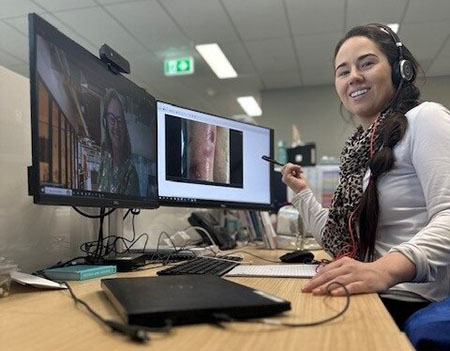Many chronic wound management services can be provided using virtual care. The three categories outlined here are those that may be most useful for NSW Health services.
Services may opt to gradually increase the services they provide via virtual care, as their capacity to use virtual care increases.
The service options can be used in any chronic wound management virtual care approach (e.g. hybrid models or dedicated virtual care services).
This is not an exhaustive list of all services available. The categories are overlapping and can be used in combination.
Specialist virtual care consultation with the consumer and care team
These services involve a chronic wound consumer and their usual or current service provider accessing a specialist consultation via virtual care.
These services are useful when the consumer would benefit from having their usual healthcare provider present to support assessment tasks during the consultation, to ensure the consumer can ask questions and understands what the specialist is explaining and to re-dress the wound after consultation. They also provide an opportunity for the healthcare provider to learn more about chronic wound management from the specialist.
Virtual care recipient
Consumer and their care provider/s
- The consumer is present at the consultation and may include a carer and/or family member.
- The care provider may include the consumer’s community nurse, primary care team, Aboriginal health practitioner, aged care staff, emergency department staff or inpatient ward staff.
- The consumer and their care provider may be together in a healthcare or home setting, or they may join the consultation virtually from separate locations.
Virtual care provider
Chronic wound management specialist or specialist from a related area of care
A healthcare worker providing specialist consultation to the consumer and their usual care team could include:
- a specialist wound management clinician, such as a nurse, medical practitioner, or podiatrist
- a medical specialist in a related or co-morbid clinical area, e.g. a vascular surgeon, burns specialist, infectious diseases physician or endocrinologist
- allied health professionals, e.g. a social worker, dietitian or occupational therapist
- multidisciplinary teams, e.g. high risk foot service or spinal injuries unit
Services provided virtually
Any aspect of clinical care
- Assessment
- Wound aetiology or diagnosis
- Management plans and treatment regimes
- Supervision of treatment
- Follow-up appointment
- Case conferences with the consumer
Virtual care modalities
Visual, audio and digital options
- Video conferencing platforms
- Telephone
- Wound photography and store and forward
- Artificial intelligence clinical decision-making tools
Service examples
In the Murrumbidgee Local Health District (MLHD), Southern NSW Local Health District (SNSWLHD) and Western NSW Local Health District (WNSWLHD) virtual care wound management services, the consumer attends the initial consultation at their local health service with their usual care provider, for example a community nurse, Aboriginal health practitioner or the multipurpose service team.
Attending the local health facility means there is access to appropriate videoconferencing equipment and a reliable internet connection, as well as a safe clinical environment for the local healthcare worker to perform any required assessments, wound treatments or dressings.

The wound management specialists, often a clinical nurse consultant (CNC) at a base hospital, will connect virtually and collaborate with the consumer and local healthcare worker to undertake a comprehensive assessment, identify the consumer’s management goals, co-design a management plan and supervise wound treatment on the day.
The wound management teams also collaborate virtually with specialist tertiary unit, e.g. the Concord Burns Unit and consumers who have returned home after acute treatment and rehabilitation.
With the local wound management CNC as a central point of contact, videoconferences are arranged between the burns unit multidisciplinary team, the consumer, their carers, the local LHD wound management team and the consumer's primary care team to discuss the consumer's progress, develop or review the management plan and answer the consumer's questions.
WNSWLHD invested in virtual care services to improve service access for people across their rural and remote communities and to provide more care on Country for Aboriginal consumers.
As well as their Virtual Wound Consultancy Service, chronic wound consumers and their care teams have access to virtual care allied health services, including virtual dietetics, occupational therapy and high-risk foot services.
The RPA Virtual Wound Care Command Centre's digital application is improving communication among health professionals and helping consumers with chronic wounds to receive prompt attention. The Tissue Analytics app is a highly advanced tool with clinician and consumer interfaces which enables engagement and integration across the usual care team, the wound care specialist nurse, and the consumer.
The app captures a digital image of a wound and analyses important clinical details such as tissue type, colour, and measurements. Using a sophisticated algorithm, the app then provides treatment recommendations to the healthcare team responsible for managing the consumer's wound. By regularly capturing images of the wound over time, the app can track and monitor changes in the wound's condition. This information is continuously used to guide and inform decisions regarding the most appropriate treatment options and allows consumers to easily connect with clinicians to facilitate video consultations in real-time.
The app allows collaboration between the usual treatment team in primary care, aged care or rural and remote settings, and the specialist wound management nurses in the Command Centre. The app enables specialist video consults, instant messaging between the care team and consumer and shared information that can be viewed and discussed in the weekly case conference led by the Sydney LHD Skin Integrity Clinical Lead and Nurse Manager.